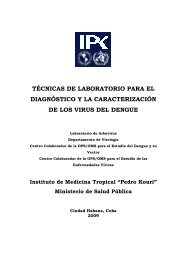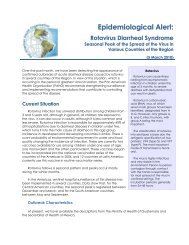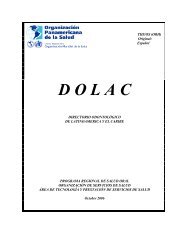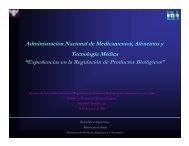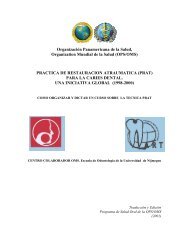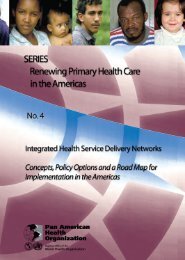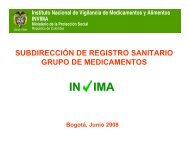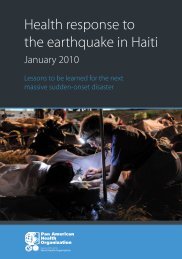Strategy and Plan of Action on Epilepsy - PAHO/WHO
Strategy and Plan of Action on Epilepsy - PAHO/WHO
Strategy and Plan of Action on Epilepsy - PAHO/WHO
Create successful ePaper yourself
Turn your PDF publications into a flip-book with our unique Google optimized e-Paper software.
51. st Directing Council / 63 .rd Sessi<strong>on</strong> <str<strong>on</strong>g>of</str<strong>on</strong>g> the Regi<strong>on</strong>al Committee<br />
15. A recent study <str<strong>on</strong>g>of</str<strong>on</strong>g> the treatment gap yielded a figure <str<strong>on</strong>g>of</str<strong>on</strong>g> 75% in low-income countries <str<strong>on</strong>g>and</str<strong>on</strong>g> over 50% in the<br />
majority <str<strong>on</strong>g>of</str<strong>on</strong>g> middle-income countries (6-8).<br />
Role <str<strong>on</strong>g>of</str<strong>on</strong>g> Auxiliary Diagnostic Tools<br />
16. The electroencephalogram (EEG) is a useful tool for the diagnosis <str<strong>on</strong>g>and</str<strong>on</strong>g> classificati<strong>on</strong> <str<strong>on</strong>g>of</str<strong>on</strong>g> epileptic syndromes.<br />
Access to the EEG is limited in many countries, <str<strong>on</strong>g>and</str<strong>on</strong>g> electroencephalographic video m<strong>on</strong>itoring is available at<br />
<strong>on</strong>ly a few specialized centers (2).<br />
17. Computerized axial tomography (CAT) remains a useful tool, owing given its low cost <str<strong>on</strong>g>and</str<strong>on</strong>g> ability to detect<br />
obvious lesi<strong>on</strong>s such as the calcificati<strong>on</strong>s from neurocysticercosis (26). Magnetic res<strong>on</strong>ance imaging (MRI)<br />
<str<strong>on</strong>g>of</str<strong>on</strong>g> the brain is recommended as the technique <str<strong>on</strong>g>of</str<strong>on</strong>g> choice for identifying the most comm<strong>on</strong> etiologies in<br />
epilepsy (27). However, neuroimaging equipment in Latin America <str<strong>on</strong>g>and</str<strong>on</strong>g> the Caribbean is rare <str<strong>on</strong>g>and</str<strong>on</strong>g> is usually<br />
c<strong>on</strong>centrated in the private sector, in additi<strong>on</strong> to being unaffordable to the majority <str<strong>on</strong>g>of</str<strong>on</strong>g> the populati<strong>on</strong> (2).<br />
Treatment <str<strong>on</strong>g>and</str<strong>on</strong>g> Rehabilitati<strong>on</strong><br />
18. The majority <str<strong>on</strong>g>of</str<strong>on</strong>g> countries in Latin America <str<strong>on</strong>g>and</str<strong>on</strong>g> the Caribbean have the four basic drugs in their arsenal<br />
(phenobarbital, phenytoin, carbamazepine, <str<strong>on</strong>g>and</str<strong>on</strong>g> valproic acid), but <strong>on</strong>ly at the sec<strong>on</strong>dary <str<strong>on</strong>g>and</str<strong>on</strong>g> tertiary levels<br />
<str<strong>on</strong>g>of</str<strong>on</strong>g> care. Ensuring the supply <str<strong>on</strong>g>of</str<strong>on</strong>g> these four antiepileptics is essential, when we c<strong>on</strong>sider that seizures can be<br />
c<strong>on</strong>trolled with m<strong>on</strong>otherapy regimens in up to 70% <str<strong>on</strong>g>of</str<strong>on</strong>g> cases. In 1990, <strong>WHO</strong> determined that the average<br />
cost <str<strong>on</strong>g>of</str<strong>on</strong>g> medicati<strong>on</strong> (with phenobarbital) could be as low as US$ 5 per patient per year (1).<br />
19. Public services in most Latin American <str<strong>on</strong>g>and</str<strong>on</strong>g> Caribbean countries do not have new generati<strong>on</strong> antiepileptics, which<br />
are useful in intractable cases but are more expensive. Measurement <str<strong>on</strong>g>of</str<strong>on</strong>g> drug-plasma c<strong>on</strong>centrati<strong>on</strong>s is not performed<br />
<strong>on</strong> a regular basis, even though it is a useful procedure (2, 28).<br />
20. Surgical interventi<strong>on</strong> for epilepsy is an effective treatment <str<strong>on</strong>g>and</str<strong>on</strong>g> is recommended in some cases that cannot be<br />
c<strong>on</strong>trolled with drugs; surgical interventi<strong>on</strong>s may reach some 10% <str<strong>on</strong>g>of</str<strong>on</strong>g> the total (1, 29).<br />
21. In the integrated management <str<strong>on</strong>g>of</str<strong>on</strong>g> people with epilepsy, c<strong>on</strong>siderati<strong>on</strong> <str<strong>on</strong>g>of</str<strong>on</strong>g> psychosocial factors is essential<br />
<str<strong>on</strong>g>and</str<strong>on</strong>g> includes educati<strong>on</strong> for self-management; that is, the measures <str<strong>on</strong>g>and</str<strong>on</strong>g> behaviors that people with epilepsy<br />
should adopt <str<strong>on</strong>g>and</str<strong>on</strong>g> maintain to c<strong>on</strong>trol their illness (30). In some cases, complementary measures can also be<br />
helpful; these include, for example, the use <str<strong>on</strong>g>of</str<strong>on</strong>g> natural products, vitamins, relaxati<strong>on</strong> techniques, a healthy<br />
diet, religious or cultural activities, <str<strong>on</strong>g>and</str<strong>on</strong>g> social support; such measures are acceptable as l<strong>on</strong>g as the patient<br />
c<strong>on</strong>tinues the basic drug therapy (31).<br />
22. The objective <str<strong>on</strong>g>of</str<strong>on</strong>g> rehabilitati<strong>on</strong> is to improve the quality <str<strong>on</strong>g>of</str<strong>on</strong>g> life <str<strong>on</strong>g>of</str<strong>on</strong>g> people with epilepsy <str<strong>on</strong>g>and</str<strong>on</strong>g> integrate them<br />
into society <str<strong>on</strong>g>and</str<strong>on</strong>g> the work envir<strong>on</strong>ment. The interventi<strong>on</strong>s that are selected will depend <strong>on</strong> the complexity <str<strong>on</strong>g>of</str<strong>on</strong>g><br />
the cases; most people with epilepsy enjoy a substantial degree <str<strong>on</strong>g>of</str<strong>on</strong>g> aut<strong>on</strong>omy <str<strong>on</strong>g>and</str<strong>on</strong>g> <strong>on</strong>ly a minority suffers from<br />
serious forms. This group includes pers<strong>on</strong>s with disabilities <str<strong>on</strong>g>and</str<strong>on</strong>g> people who are instituti<strong>on</strong>alized or highly<br />
dependent <strong>on</strong> their families; here, it is essential to develop patients’ social <str<strong>on</strong>g>and</str<strong>on</strong>g> occupati<strong>on</strong>al skills (2).<br />
Programs <str<strong>on</strong>g>and</str<strong>on</strong>g> Services<br />
23. The available data show that <strong>on</strong>ly 34% <str<strong>on</strong>g>of</str<strong>on</strong>g> countries in Latin America <str<strong>on</strong>g>and</str<strong>on</strong>g> the Caribbean reported having<br />
nati<strong>on</strong>al epilepsy programs. (2). Some <str<strong>on</strong>g>of</str<strong>on</strong>g> the key problems in delivering services to people with this disorder<br />
are the limitati<strong>on</strong>s <strong>on</strong> diagnosis, management, <str<strong>on</strong>g>and</str<strong>on</strong>g> m<strong>on</strong>itoring in primary health care. Many countries lack<br />
interventi<strong>on</strong> protocols, or those that they do have are not up-to-date (2).<br />
3





